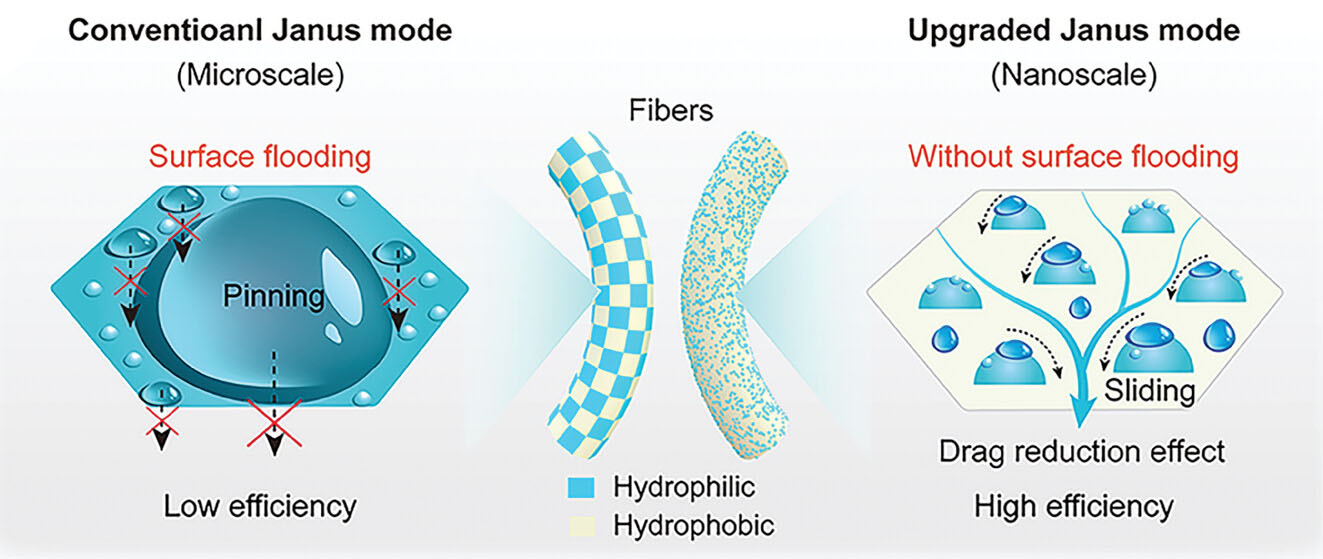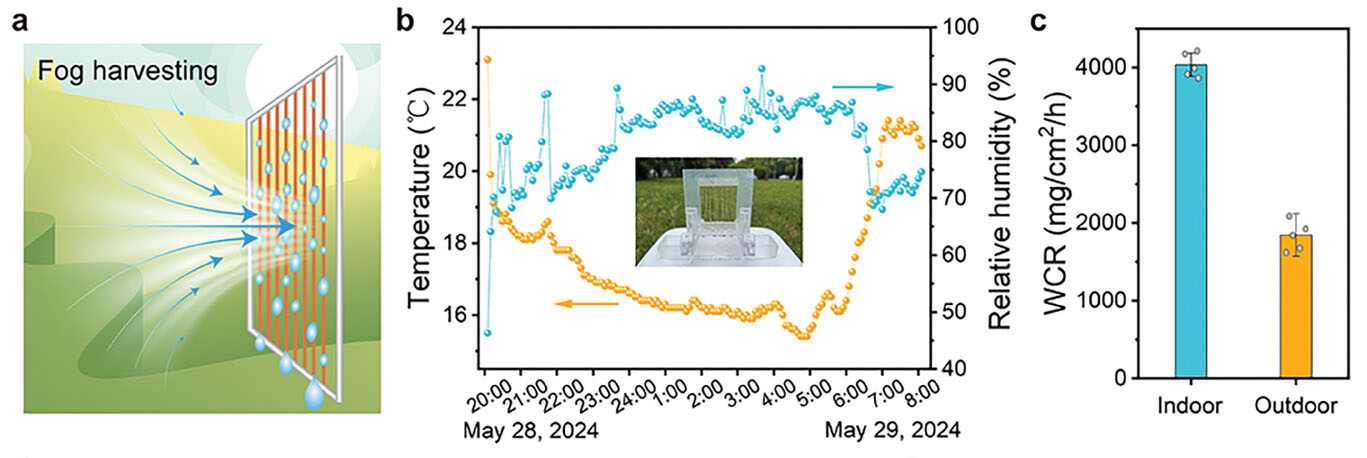| Aug 16, 2024 | |
Nanoscale engineering advances fog harvesting efficiency for sustainable water collection |
|
| (Nanowerk Spotlight) The global challenge of freshwater scarcity has spurred scientists to explore innovative solutions for sustainable water collection. Among these, fog harvesting has emerged as a promising technique, offering a way to capture water from the air without geographical or hydrological constraints. However, despite its potential, fog harvesting has faced persistent challenges in achieving efficiency levels suitable for practical applications. | |
| Researchers have long sought to mimic natural fog collection mechanisms, like those found in fog-basking beetles. These insects possess surfaces with alternating water-attracting and water-repelling regions that enable efficient fog capture. Previous attempts to recreate this pattern artificially often resulted in surfaces that collected water but struggled to shed it effectively, leading to flooding and reduced overall efficiency. | |
| A team of scientists from Donghua University in Shanghai has now developed an advanced approach to fog harvesting that addresses these longstanding issues. Their research, published in Advanced Functional Materials ("Nanoscale Drag Reduction Effect Enables Efficient Fog Harvesting"), introduces a novel fiber design with nanoscale modifications that significantly enhance water collection rates. | |
| The key innovation lies in what the researchers term an "upgraded Janus mode" – a surface structure that combines hydrophobic (water-repelling) properties with precisely engineered nanoscale hydrophilic (water-attracting) sites. This design builds upon previous "conventional Janus mode" approaches that featured larger-scale alternating hydrophobic and hydrophilic regions. | |
 |
|
| Comparison of conventional Janus mode and upgraded Janus mode on the fiber surface. (Image: Adapted from DOI:10.1002/adfm.202411083 with permission by Wiley-VCH Verlag) | |
| Crucially, this new design introduces a nanoscale drag reduction effect, which is fundamental to its improved performance. By shrinking the hydrophilic areas to the nanoscale, the researchers created fibers that can capture water droplets efficiently while also allowing them to slide off more easily due to reduced surface drag. This balance is crucial for maintaining a high turnover rate of water collection without surface flooding, a common problem in conventional designs. | |
| The team achieved this nanoscale surface engineering through an in situ molecular confined modification strategy. They started with polyacrylonitrile (PAN) fibers and chemically grafted tannic acid (TA) onto the fiber surface. This process introduced numerous hydrophilic sites. They then selectively modified some of these sites with a hydrophobic compound, octadecylamine (ODA), creating a carefully controlled pattern of nanoscale hydrophilic regions within a predominantly hydrophobic surface. | |
| This molecular-level surface modification resulted in fibers with unique water interaction properties. Water droplets forming on the fiber surface quickly coalesce into larger droplets, but due to the reduced adhesion from the nanoscale hydrophilic sites, these droplets can slide off the fiber at a much smaller volume compared to conventional designs. | |
| The success of this new fiber design is rooted in a careful balance of various forces acting on water droplets. In fog harvesting, two key challenges are the re-entrainment of captured droplets back into the air stream and the pinning of droplets to the surface. The researchers analyzed these phenomena in detail. | |
| The aerodynamic drag force, which can cause re-entrainment, is countered by the adhesion force that keeps droplets on the surface. In conventional designs, strong adhesion can lead to droplet pinning and surface flooding. The nanoscale hydrophilic sites in the new design reduce this adhesion force, allowing droplets to slide off at a smaller volume. | |
 |
|
| a) Schematic diagram of outdoor fog harvesting for PAN-TO Harp. b) Weather data for May 28–29, 2024, in Shanghai. (Insert: the photo of fog harvesting device). c) Comparison of WCR between indoor and outdoor tests. (Image: Adapted from DOI:10.1002/adfm.202411083 with permission by Wiley-VCH Verlag) | |
| Additionally, the researchers considered the balance of gravity, lateral adhesion force, and a driving force induced by the wettability gradient on the fiber surface. This combination of forces promotes the directional movement of water droplets along the fiber, enhancing collection efficiency. | |
| Unlike conventional Janus mode designs, where larger hydrophilic regions often lead to surface flooding and reduced efficiency, the upgraded Janus mode with its nanoscale hydrophilic sites effectively mitigates this issue. In traditional designs, water droplets tend to accumulate and merge into larger droplets that remain pinned to the surface, blocking new fog droplets from being captured. | |
| The new design's nanoscale features significantly reduce the critical volume size required for water droplets to slide off the surface. This means that droplets are shed more frequently, continually exposing fresh capture sites. As a result, the PAN-TO fibers achieved a water collection rate of 4,035 milligrams per square centimeter per hour, markedly exceeding that of most materials with conventional Janus mode designs. | |
| This improvement addresses one of the most persistent challenges in fog harvesting technology: the trade-off between efficient water capture and effective water shedding. By optimizing both aspects simultaneously, the upgraded Janus mode represents a significant leap forward in fog harvesting efficiency. | |
| The researchers demonstrated the effectiveness of their approach by constructing a harp-like fog collector using these modified fibers. In laboratory tests, this collector achieved the aforementioned high water collection rate. Beyond the impressive collection rate, the new fiber design also addresses another critical challenge in fog harvesting technology: durability. The chemical bonding between the hydrophilic substance and the fiber substrate results in a strong interfacial connection. This enhanced durability allows the fibers to maintain their performance even after exposure to water and sand flushing, simulating harsh environmental conditions. | |
|
|
|
| Fog collection on the PAN fiber surface. | |
| The potential applications for this technology extend beyond simply collecting drinking water. The research team demonstrated the use of harvested fog water for agricultural irrigation and textile dyeing processes. Seeds irrigated with the collected water showed successful germination and growth, while fabrics dyed using the harvested water exhibited color quality comparable to those dyed with conventional tap water. | |
| These practical demonstrations highlight the versatility of fog harvesting as a water source for various industries and applications, potentially reducing reliance on traditional freshwater sources in water-stressed regions. | |
| The study also sheds light on the complex physics involved in fog harvesting. The researchers conducted detailed analyses of the forces acting on water droplets as they form, grow, and eventually slide off the fiber surface. This understanding of the interplay between gravity, surface tension, and adhesion forces at the microscale could inform future designs of water collection systems across various applications. | |
| While the results are promising, it's important to note that the study primarily focused on laboratory conditions. The researchers did conduct some outdoor tests, which showed reduced but still significant water collection rates compared to controlled indoor experiments. This reduction was attributed to fluctuating humidity levels and increased evaporation in real-world conditions. | |
| Future work will likely need to address scaling up the production of these specialized fibers and optimizing fog collector designs for diverse environmental conditions. Additionally, long-term field studies will be crucial to fully assess the technology's performance and durability in various climates and locations. | |
| The development of this advanced fog harvesting technology represents a significant step forward in addressing global water scarcity challenges. By harnessing atmospheric moisture more efficiently, such systems could provide a sustainable water source for communities in fog-prone regions, potentially reducing pressure on traditional freshwater resources. | |
| Moreover, the fundamental insights gained from this research into surface wettability and water droplet behavior could have broader implications. The principles of nanoscale surface engineering demonstrated here might find applications in other areas where controlling liquid-solid interactions is crucial, such as in heat transfer systems, anti-icing technologies, or even biomedical devices. | |
 By
Michael
Berger
– Michael is author of three books by the Royal Society of Chemistry:
Nano-Society: Pushing the Boundaries of Technology,
Nanotechnology: The Future is Tiny, and
Nanoengineering: The Skills and Tools Making Technology Invisible
Copyright ©
Nanowerk LLC
By
Michael
Berger
– Michael is author of three books by the Royal Society of Chemistry:
Nano-Society: Pushing the Boundaries of Technology,
Nanotechnology: The Future is Tiny, and
Nanoengineering: The Skills and Tools Making Technology Invisible
Copyright ©
Nanowerk LLC
|
|
|
Become a Spotlight guest author! Join our large and growing group of guest contributors. Have you just published a scientific paper or have other exciting developments to share with the nanotechnology community? Here is how to publish on nanowerk.com. |
|
